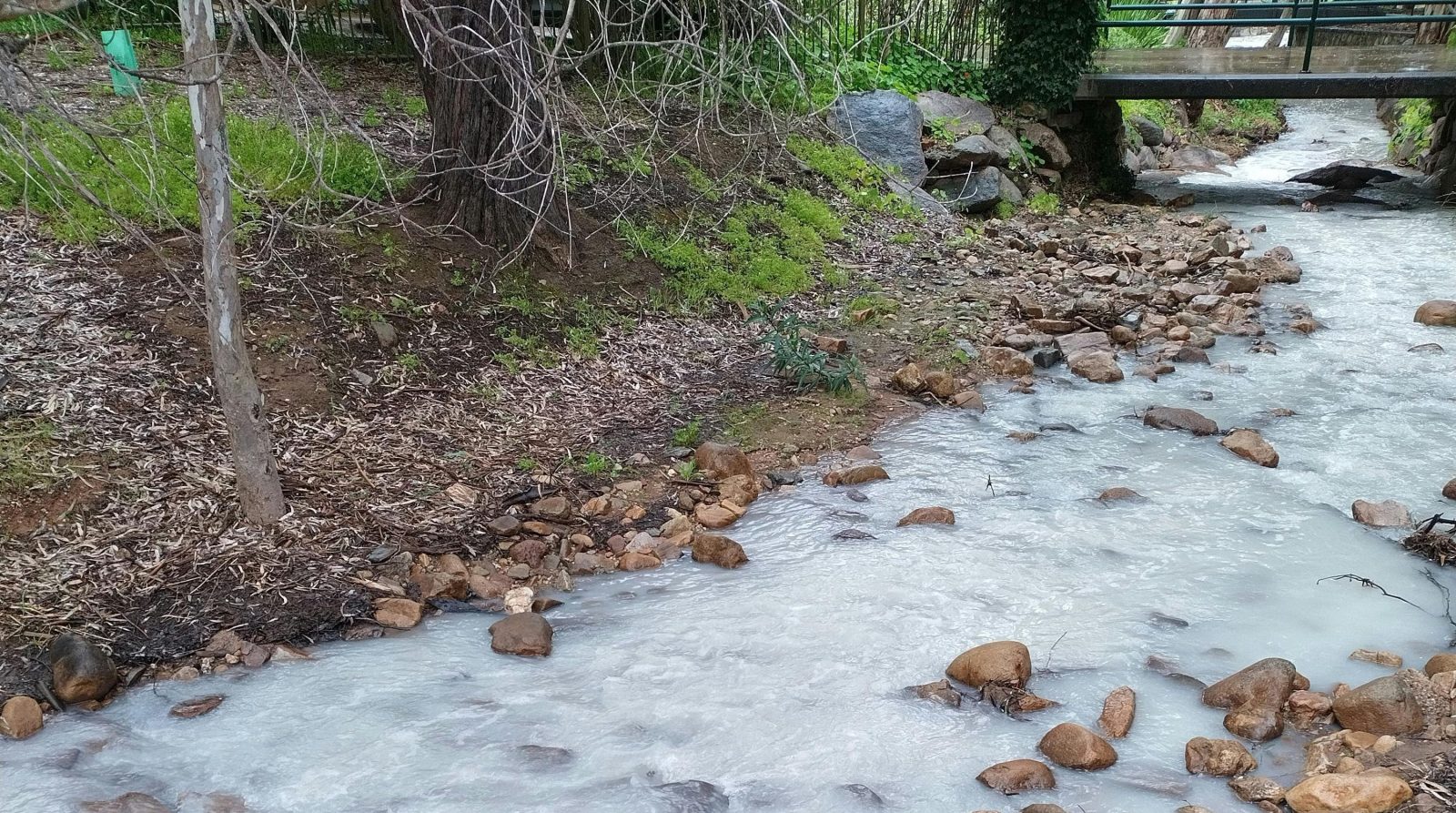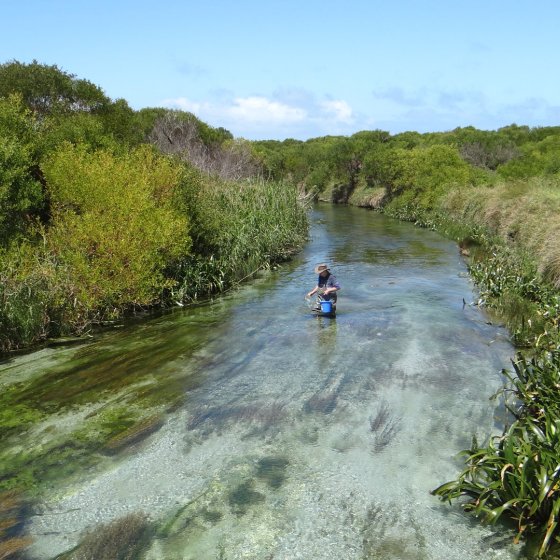- Home
- Environmental Themes
- Waters
- Pressures & Responses
- Pollution
Pollution
Wastewater
Pressures
- Wastewater discharge and leachates from industries, which can include wastewater treatment plants, desalination plants, mining and extractive industries, dairies, boats and marinas.
- Potential pollution from construction and development of housing and other buildings.
- Leaking septic tanks, runoff from aerobic systems and discharge from council community wastewater management systems (CWMS) or SA Water wastewater treatment plants (WWTPs).
- Impacts
- Wastewater from industries has the potential to affect groundwater and surface waters causing aesthetic impacts and/or impacts to ecosystem health or human health, for example, quarries.
- Construction of new developments may result in sediment runoff, during rainfall, into waterways and stormwater, impacting ecosystems, for example, Nairne housing development.
- Dewatering of groundwater on construction sites often leads to increased discharges to the stormwater system and creeks or the marine environment. Often the quality of groundwater is unknown.
Responses
- The Environment Protection Act 1993 requires the licensing of certain activities that potentially pose a risk to the aquatic environment. This includes WWTPs, CWMS, extractive industries and other industrial processes that have the potential to pollute water resources. Licence conditions may impose certain restrictions or require improvements to operations.
- Some industries that discharge wastewater and other pollutants into surface water or groundwater are also required to report their emissions through the National Pollutant Inventory. The majority of these facilities consist of wastewater treatment plants. The EPA uses NPI data to calculate the resource efficiency fee for load-based licensing.
- Local government, SA Health and the EPA are involved in the management and regulation of wastewater discharge and seepage from domestic on-site wastewater systems.
- Reuse and recycling of wastewater provides a number of environmental benefits, including reduction of discharges of wastewater and stormwater into receiving waters and reduced pressure on use of existing water resources. SA Water and local councils reuse and recycle wastewater from WWTPs and CWMS. SA Health provides guidance and regulates the use of recycled water for other purposes.
- Compliance assessments may be undertaken by the EPA or local government on activities that discharge wastewater if impacts are observed.
- Water quality monitoring and wastewater treatment may be required.
Opportunities
- Increase the reuse and recycling of wastewater from CWMS and WWTPs, so less wastewater is discharged into receiving waters.
- Further measures to reduce discharges into watercourses from on-site wastewater systems (leaky septics or poorly operated aerobic systems), for example, more CWMS, subsidies for sewer connections and encourage a change from septics to aerobic systems (as per the previous Adelaide Hills Council ‘waste control program’).
- Better education and training for the construction industries on their requirements to prevent wastewater and sediments from entering waters, so the risks of potential impacts and need for compliance is reduced. Improved compliance of new developments to ensure there is minimal risk of impacts to stormwater or waterways.
Chemicals and Toxic Substances
Pressures
- Depositing of chemicals on land where they may enter waters (this includes legacy issues where inappropriate chemical use and disposal has occurred in the past). Issues may include chemical use and spills, and managing contaminants from sites that may spread into waters during firefighting.
- Pesticide and herbicide use on agricultural land.
- Leaking septic tanks, runoff from aerobic systems and discharge from CWMS or other wastewater treatment plants.
- Extraction of toxicants such as heavy metals and acids when mining extractives.
Impacts
- Contamination of groundwater and surface waters from various toxicants.
- Spray drift and runoff of water from treated land may impact non-target species of plants and animals, and other industries.
- Nutrients, pharmaceuticals and personal care products, and pathogens reaching surface water and groundwater.
- Potential for antimicrobial resistance resulting from release of pharmaceuticals, antibiotics, fungicides and other antimicrobials into waters and onto land where it may enter waters.
Responses
- Establishment of groundwater prohibition areas to protect both current and future landholders from accessing the contaminated groundwater.
- Implementation of the Site Contamination Regulatory Framework and Orphaned Site Contamination Framework by the EPA to regulate and assess site contamination. For example, the EPA orphaned site assessment for southeastern Edwardstown.
- PIRSA are responsible for regulating and managing chemical use and reporting of spray drift. A total of 32 chemical trespass incidents were recorded by Rural Chemicals Operations in 2022–23. Of these, 24 were worthy of further investigation. Not all of these incidents would have impacted waters.
- A Memorandum of Understanding (MOU) between the EPA and the DEM where the latter is the lead regulatory agency through the Petroleum and Geothermal Energy Act 2000 and associated Regulations. The EPA supports DEM by administering the Environment Protection Act 1993 and associated environment protection policies.
- Cooperative Research Centre SAAFE addressing antimicrobial resistance due to discharge of pharmaceuticals.
Opportunities
- Strengthen legislation to ensure future accountability of polluters.
- Better education on pesticide and herbicide use, and ensure that appropriate records are maintained during the transportation and application of these chemicals.

Stormwater
Pressures
- Potential pollution of waters from increased stormwater runoff from roads and residential areas into waterways.
- Clearance of land for urban development.
- Discharge of pollutants into stormwater systems, for example, from business activities, sweeping leaves into stormwater, wash-down water from washing cars and boats, oil leaks and tyre wear.
Impacts
- Sediment transport causing increased turbidity and smothering aquatic flora and fauna.
- Toxicity to flora and fauna from pollutants present in road runoff.
- Nutrients causing algal blooms.
Responses
- Implementation of water sensitive urban design by a number of councils includes wetlands, rain gardens, permeable paving, infiltration systems and other features to capture and/or filter stormwater prior to it reaching our waterways.
- Environment Protection (Water Quality) Policy 2015 prohibits listed pollutants such as wash-down water and organic matter being deposited or discharged into stormwater.
Opportunities
- Expand the installation of wetlands and rain gardens to treat stormwater through an incentive program.
- Provide incentives to councils to install water sensitive features rather than pit and pipe replacement when replacing or upgrading existing infrastructure.
- Ensure that all water sensitive urban design infrastructure for stormwater management is appropriately and regularly maintained to ensure optimal performance. If these devices are not properly maintained, they achieve little to no effective treatment.
- Encourage councils/developers to install roadside swales, rather than concrete gutters, to capture stormwater.
- Improve education to ensure people understand legal requirements and the reason why certain activities are not permitted, for example, washing cars on the roadside and sweeping leaves and dirt into stormwater drains.
Waste
Pressures
- Rubbish, debris and sediment from various sources, including construction, litter, buildings and properties, entering waterways via stormwater and floodwaters resulting in ecosystem impacts and disrupting water flow.
Impacts
- Microplastics from plastic waste have been found in urban streams and coastal environments, which can be ingested by aquatic animals and can impact ecosystems.
- Debris, rubbish and sediment can smother habitats impacting plants and animals. It can also disrupt water flow of streams and rivers.
Responses
- Installation of gross pollutant traps (GPTs) by councils and government to collect rubbish and debris prior to stormwater entering waterways. Green Adelaide indicated that 2,300 to 3,300 tonnes of rubbish are removed annually from GPTs in the River Torrens and Patawalonga catchments.
- Research undertaken to improve our understanding of the extent and impact of microplastics in our waters.
- South Australia’s ban on single-use plastics to help minimise the amount of plastic in our environment.
- Development and promotion of the circular economy to reduce waste and litter.
Opportunities
- Improvements in stormwater management helping to capture plastics before they reach inland waters or the marine environment.
- Better education and compliance regarding littering and management of sites to prevent waste from entering waters including stormwater.
Check out
Nutrients
Pressures
- Nutrient inputs from various sources (for example, stormwater runoff, application of fertilisers, animal manure and industries).
Impacts
- Excess nutrients can result in harmful algal blooms. These blooms can be harmful to fish and invertebrates, smother native vegetation and cause low dissolved oxygen levels.
- Challenges with managing nutrient inputs if the source is unknown.
Responses
- The EPA undertakes aquatic ecosystem condition monitoring of waterways around South Australia to identify the health of waters and what may be impacting them.
Opportunities
- Undertake catchment audits to identify and address sources of pollutants for better-targeted prevention activities.
- Implement an improved sampling design for the EPA aquatic ecosystem condition program that will more effectively enable the assessment of trends in condition or changes in biological communities or water quality over time. Currently, sites for some regions are specifically selected to inform broad condition assessments across each region. Other parameters collected by agencies, such as fish communities by SARDI, could also be incorporated into assessments to inform ecosystem condition.
